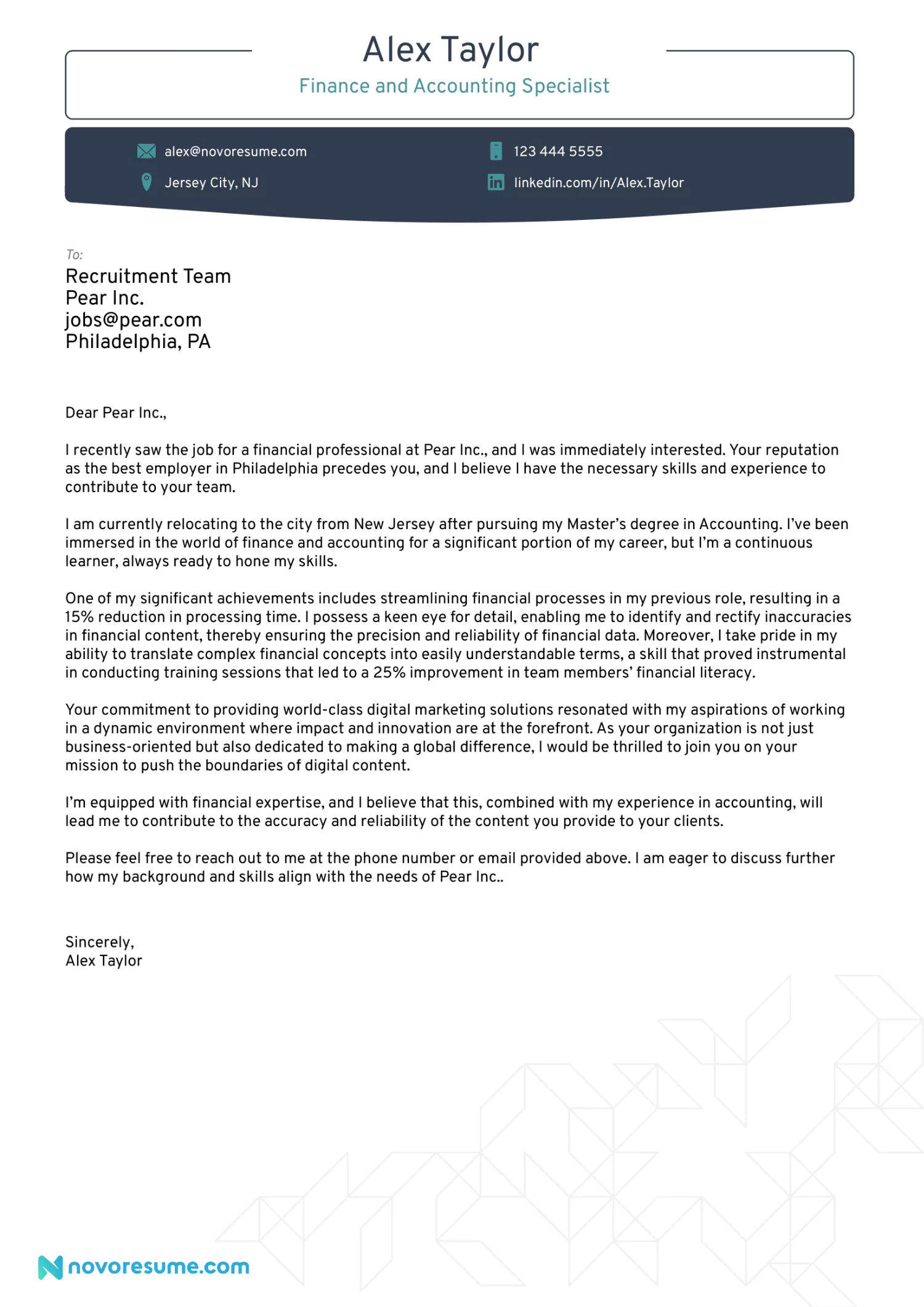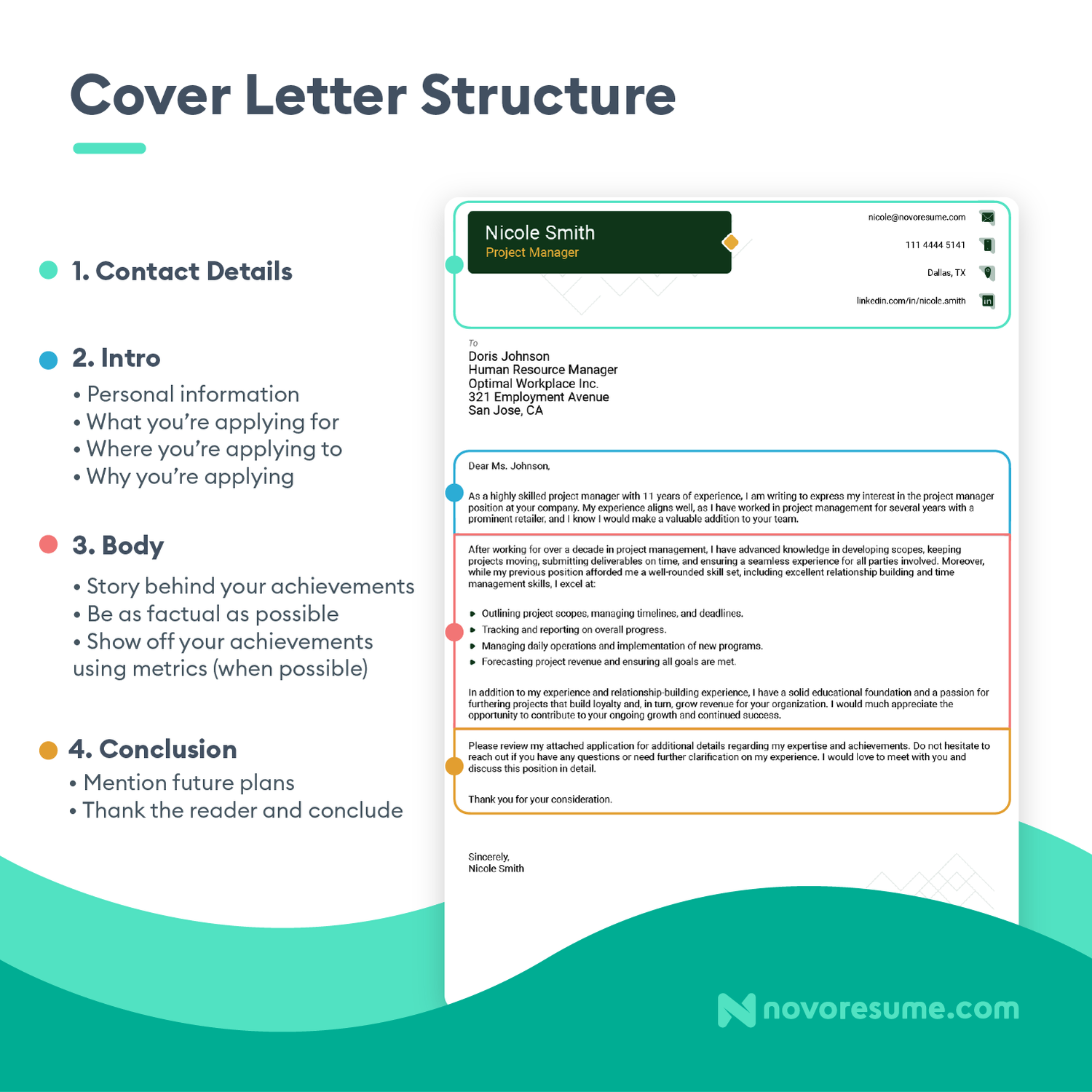You can navigate the landscape of numbers, investments, and economic intricacies.
You’re a financial pro, and you’ve got the expertise to prove it.
But there's just one thing standing between you and a successful job application – your cover letter.
Writing a compelling finance cover letter can feel more complicated than analyzing stock market trends. You might find yourself paralyzed with no idea how to prove your financial prowess.
Don’t worry! We’re here to guide you through it.
In this article, we’re going to cover:
- What an Amazing Finance Cover Letter Looks Like
- 5 Steps to Writing a Job-Winning Finance Cover Letter
- 3 Essential Finance Cover Letter Tips
Let’s go!
Finance Cover Letter Example

5 Steps for the Perfect Finance Cover Letter
Now that you know what a great cover letter looks like, you're all set to write your own!
Just follow these straightforward steps:
#1. Put Contact Information in the Header
Start your finance cover letter by creating a header for your contact details, the same as on your resume.
Here's what you should have in there:
- First and Last Name. Make sure your full name is in plain view at the top.
- Professional Title. Match this with the specific finance role you're after. Hiring managers usually hire for several roles at once, so this will help them notice your application.
- Email Address. Keep it professional, like a combo of your names. The quirky high school email won't cut it. (e.g.: moneymaker14234@hotmail.com is not a good look, but john.f.doe@gmail.com is fine.)
- Phone Number. Ensure your phone number is accurate since employers need to reach you easily. A missed digit could mean a missed interview.
- Location. Usually, city and state/country are enough. But if you're open to relocating or working remotely, mention it.
- Relevant Links (optional). Share your LinkedIn or any other relevant social media that can back up your financial expertise.
Now, let's talk about reaching the hiring manager’s contact information:
- Company Name. Mention the financial institution you're applying to.
- Hiring Manager's Name. If you can find it, great! Check the job listing, the company's website, or LinkedIn profile.
- Hiring Manager's Title. If they've got a fancier title than “Hiring Manager”, such as “Chief Financial Officer”, address them accordingly.
- Location. City and state/country details are crucial, especially for global firms.
- Date of Writing (optional). Adding the date you penned your letter gives it a professional touch.
#2. Address the Hiring Manager
Once you've sorted out your finance cover letter's contact details, it's time to address it properly.
Say goodbye to the generic "To Whom It May Concern."
The right greeting can make a positive impression on the hiring manager and set the tone for your entire finance cover letter.
Start with some research. Check the job ad, the company's website, or their LinkedIn profile to identify the finance department's hiring manager. Find their name and use it.
Be sure to address them professionally. You can use “Ms.” or “Mr.”, followed by their last name. But if you're unsure about their gender or marital status, simply use their full name. For example:
- Dear Ms. Anderson
- Dear Emily Anderson
And if you can't find information about the hiring manager or the head of the finance department, address your letter to the department or the company as a whole:
- Dear Finance Department
- Dear Finance Hiring Team
- Dear Human Resources Team
- Dear Head of Finance
#3. Write an Eye-Catching Opening Statement
As the saying goes, time is money, and hiring managers value time a lot. In fact, it doesn’t take them more than a few seconds to decide if an application is worth reading in detail.
That's why writing a strong introductory paragraph in your finance cover letter is essential. Start by introducing yourself as a professional and clearly stating why you're enthusiastic about the position. Showing your passion for the finance industry or the specific role can instantly capture the hiring manager's attention.
But conducting some research on the company can significantly boost your chances, too. The more insights you gather about the employer, the better you can show them your alignment with their work culture or company goals. This shows that you're not applying randomly; you genuinely have your sights set on this specific opportunity, and you’re ready to put in the work.
Depending on your level of experience, you can also kick off your cover letter with an accomplishment or a skill that makes you an ideal fit for the role. Just make sure that this paragraph isn’t too lengthy. All you need to do is spark the hiring manager's curiosity and encourage them to explore your cover letter further.
#4. Use the Cover Letter Body for the Details
The body of your cover letter is where you have to prove you’re the ideal candidate for the position.
But don’t repeat what it says on your finance resume. This is your opportunity to really show your financial prowess and qualifications in a way that leaves a mark. Your mission is to persuade the hiring manager that you're the standout choice among the competition, even if they have similar experience and skills.
So shine a spotlight on any noteworthy achievements you have and use the job advertisement as inspiration.
Tailoring your cover letter to align with the specific job ad is crucial. You should emphasize skills and experiences that resonate with the company's needs. For example, if you're applying for a finance role in a tech-driven firm, focus on your tech-related financial skills rather than more generic experiences in finance.
Be sure to demonstrate your understanding of the company, its financial model, or the intricacies of the finance industry as a whole. If you're well-acquainted with the company's financial products or services, mention it in your cover letter to show how and why your financial expertise aligns seamlessly with the company’s mission and corporate culture.
Lastly, let your enthusiasm for the role shine through your words. Convey your genuine excitement for the position and your confidence in your ability to contribute to the company. Show them that you're not just another candidate but the financial talent that meets all their requirements.
If you need even more inspiration, check out our other cover letter examples!
#5. Wrap It Up and Sign It
The ending of your finance cover letter is your opportunity to leave a lasting impression on the hiring manager.
Start closing your finance cover letter by confidently reiterating why you’re the perfect fit for the role and giving a brief recap of your key skills that prove it.
After that, it’s time for a call to action. Encourage the hiring manager to take the next step, whether it's scheduling an interview or exploring your application in more detail. A well-placed call to action can make all the difference and get you closer to your dream job.
Finally, choose an appropriate closing line. And don’t forget to sign your full name underneath. Like so:
Please don't hesitate to reach out to me via the provided email or phone number so that we may further discuss my application. I eagerly await the opportunity to go over how I can help Company X on its mission to success.
Best regards,
John Roe
And if you're seeking an alternative to "Best regards," consider these options:
- Sincerely,
- Warm regards,
- Respectfully yours,
- Thank you for your consideration,

3 Essential Finance Cover Letter Tips
You've got the basics of cover letter writing under your belt!
Now it's time to refine yours with some essential cover letter tips:
#1. Match Your Resume
Clarity is important in the finance industry, and the best place to start with it is on your cover letter.
You have to make sure your finance cover letter’s formatting and layout align with your finance resume as much as possible. This can convey a polished and well-organized image of you as a candidate and make it easier for the hiring manager to identify your application out of the bunch.
So keep your text neatly arranged on the page and maintain uniform font styles and sizes. Pay attention to the page margins and line spacing so your cover letter remains concise and still fits on a single page.
Or Use A Cover Letter Template Instead
Feeling overwhelmed?
Just try our resume builder and matching cover letter templates to make crafting your application easier.
Each template is crafted with input from hiring experts worldwide, so they meet all industry standards and look gorgeous.
#2. Mention Skills and Keywords
You don’t want your finance cover letter to come off as generic.
Try to mention as many keywords from the job advertisement as you can. Hiring managers already know what they want from a candidate, so you have to show them you meet all their criteria.
Doing this proves you’ve paid careful attention to the job advertisement, and it also directs hiring managers to the information they care the most about. Just don’t throw in those keywords randomly!
You want to build a narrative that shows your expertise. Focus on the most important skills mentioned in the job ad that match the ones you already have, and explain how they’ve helped you excel at your job.
#3. Add Any Relevant Links
Your finance cover letter should match your resume’s contact information down to a T.
So, if you added any relevant links to one, make sure the other has them, too. Specifically, when it comes to listing personal websites or social media profiles like LinkedIn, hiring managers appreciate it.
This gives them quick and easy access to see your previous work instead of having to circle back to your resume to find a link. They could even connect with you directly on LinkedIn, so this extra touch of accessibility and professionalism can leave a great impression on potential employers.
Key Takeaways
And you’re all set with writing your finance cover letter!
After reading our guide, we trust you’re well-equipped to secure the exact job you have your sights set on.
Before you head off, let’s summarize some main points from our article:
- Your finance cover letter’s look should match your resume since it shows professionalism, and attention to detail, and makes it easier for the hiring manager to spot your application. Use a resume builder with matching cover letter templates to save time.
- Keep your contact information factual and professional. You don’t want to use an immature email address from your high school years since it could leave a bad impression.
- Include any skills and other keywords from the job description in the body of your cover letter. Use them to illustrate how your experience matches what the employer is looking for and to present yourself as an ideal candidate.
- Wrap up your cover letter with an appropriate closing line, and don’t forget to sign your name at the bottom. This little detail is the bow that ties together a spotless application.

